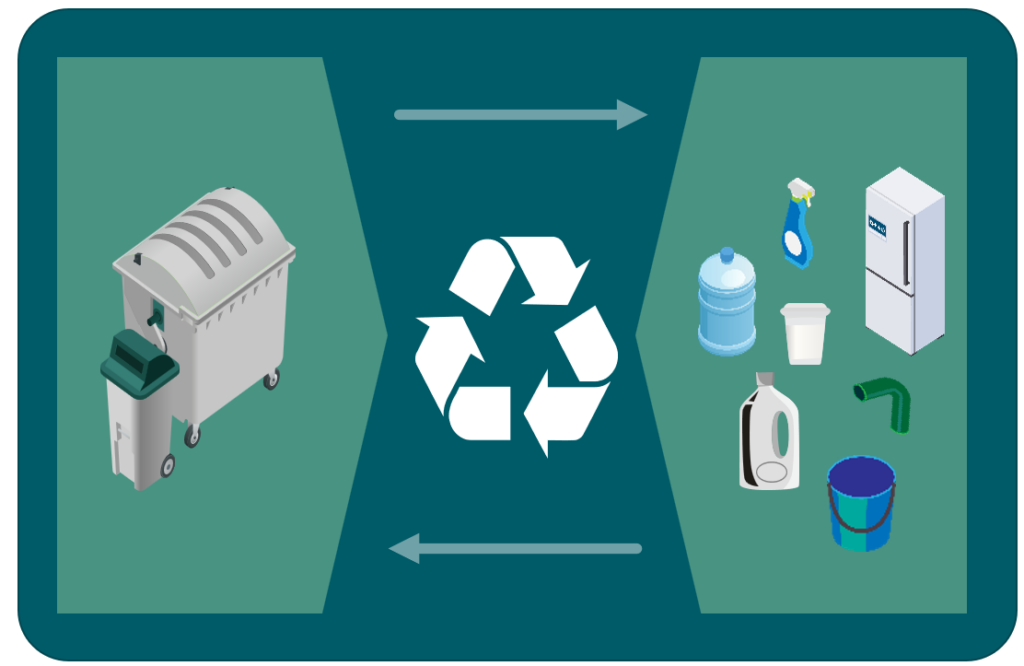Project Objective: Map, simplify, and pilot circular loops in the municipal solid waste (MSW) value chain by identifying the best recycling technologies and channelling waste into high-value circular products.

Circular MSW Project Approach
- Phase 1: Define MSW volumes, waste composition and treatment in different regions, assessing 2 regional archetypes (with and without pre-sorting)
- Phase 2: Evaluate and prioritize recycling technologies along key criteria
- Phase 3: Assess optimal circular pathways (waste mgmt. to recycling) and trade-offs for MSW
- Phase 4: Help define, build and adjust the waste mgmt. set-up to enable MSW recycling
Why this matters:
Globally, over 2 billion tonnes of municipal solid waste (MSW) are generated each year, and at least 33% of it is not managed in an environmentally sound manner (World Bank, 2023). Yet buried within this waste is a largely untapped resource: carbon. Much of this carbon—currently lost to landfill or incineration—can be captured and converted into valuable circular feedstocks for the chemical industry, enabling a more sustainable and resource-efficient future.
This project brings together stakeholders across the value chain to increase the circularity of MSW by identifying high-potential waste streams, optimizing technology pathways, and enabling system-level change in waste management practices. By producing circular and renewable raw materials from MSW, the initiative aims to reduce landfill reliance, inform future investments in technology, and support the redesign of collection, sorting, and treatment systems. Finally, the project aims to build a pilot to validate the technical, economic, and environmental performance of selected pathways—demonstrating how MSW can be transformed from a burden into a building block for sustainable products.
GLOBAL IMPACT TOPIC: Circularity
CHALLENGES TO ADDRESS:
In Europe alone, over 50% of municipal solid waste is still treated through landfill or incineration—practices that must be drastically reduced to meet the EU’s 10% landfill target by 2035.
VALUE OF GIC’S COLLECTIVE APPROACH:
GIC provides a platform to identify and scale viable pathways for converting waste into recycled or renewable feedstocks, turning a regulatory challenge into an opportunity for innovation and circularity.
Waste collection, sorting, and treatment are managed by different players with limited coordination, slowing down systems-level innovation.
By collaborating across sectors—from waste management to chemical production—GIC helps align infrastructure, technology, and market demand to build circular MSW value chains that work in practice.
Numerous solutions exist for converting MSW into feedstock, but there’s a lack of clarity on which offer the best environmental, technical, and economic performance.
GIC enables joint piloting, comparison, and validation of different technologies, accelerating the selection of scalable and high-impact pathways.
Individual companies face high R&D costs and risk duplication when working in isolation.
Pooling resources and knowledge across GIC members reduces costs, avoids redundant trials, and accelerates collective learning—de-risking investment and speeding up deployment.
Open call for innovators to join the project
We are looking for specialized innovators in municipal solid waste to provide expert inputs via interviews &/or workshop participation, in direct collaboration with the GIC and its selected project partners.
Find out more about the GIC Innovation Ecosystem.

